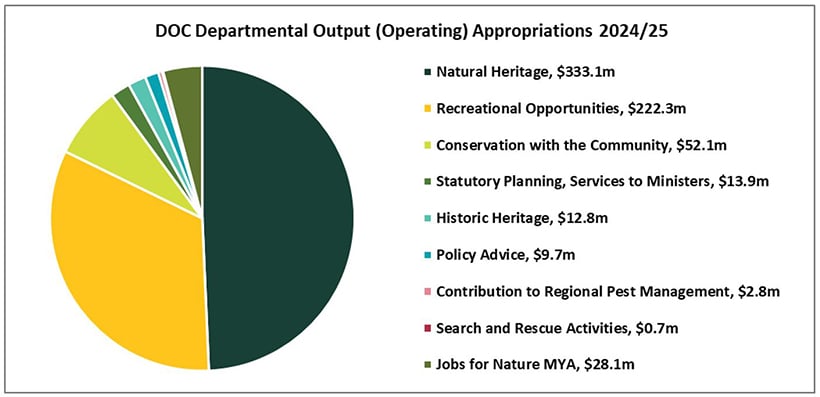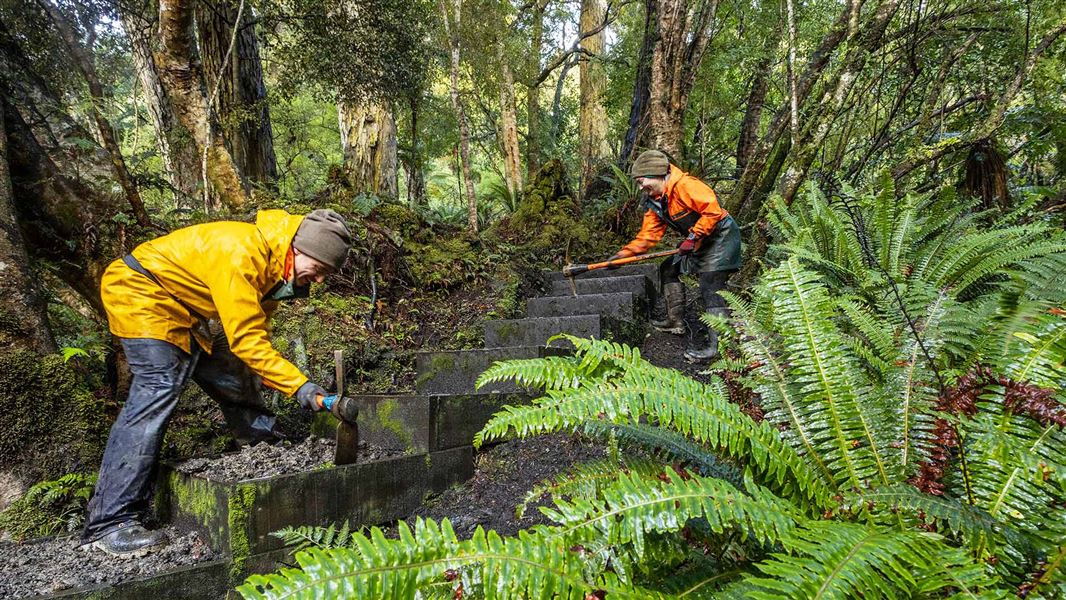Archived content: This media release was accurate on the date of publication.
Date: 30 May 2024
Like all government agencies, the Department of Conservation (DOC) has been directed by Government to find savings. DOC’s ongoing Baseline Savings Target (BST) is $31.341 million per annum from 2024/25. The BST savings are 6.5% of the DOC baseline that was eligible for savings.
The Department of Conservation’s Budget 2024 savings initiatives fit into three categories: programme savings; savings from enabling functions; and savings from external services.
DOC was also asked to make additional one-off savings of $8.930 million in 2024/25 (comprised of $6.930 million for the Kermadec Ocean Sanctuary and $2 million from Jobs for Nature).
Wider cost pressures
On top of Government’s BST, DOC has significant non-discretionary and demand-driven cost pressures. This includes contracted pay adjustments and general price increases. The cost pressures equate to $6.9 million in 2024/25; and an estimated additional $16.3 million in 2025/26.
The cost pressures DOC faces can be met for two years from the savings proposed. The Department faces ongoing cost pressures that will need to be met beyond 2025/26.
In total, the BST and DOC’s cost pressures combined mean that DOC has total savings of $47.2 million in 2024/25 and anticipates total savings of $54.6 million in 2025/26.
Budget 2024 initiatives
There are technical operational budget changes being made to the budget for the Department totalling $42 million.
DOC’s Budget 2024 savings include:
- $13.360 million per annum ongoing reduction in the Jobs for Nature programme. There is an additional one-off saving of $2.000 million in 2024/25. This Jobs for Nature funding had not yet been allocated to any projects therefore no work needs to be stopped, however the ability to top-up existing projects in 2024/25 and 2025/26 will no longer be available.
- $3.089 million ongoing reduction in the Kermadec Ocean Sanctuary programme and an additional one-off saving of $6.930 million in 2024/25. In March 2024, the Government announced plans to stop work on the Kermadec Ocean Sanctuary Bill. This means no funding is required as the work has stopped.
- $2.000 million ongoing reduction in the Contaminated Sites Programme. This means that setting up the Contaminated Sites Programme will be slowed down. Affected sites will continue to be managed as they are.
- $11.257 million ongoing reduction in contractors, consultants, and back-office functions, which are parts of DOC that support frontline delivery, such as fleet, property, procurement and operational planning.
- $1.635 million ongoing reduction in the Legal, Regulatory Services and Strategic Partnerships functions.
The Department had an FTE count on 30 April 2024 of 2,706 (includes permanent and fixed term staff). Budget savings from the BST and cost pressures will mean that 257 positions will be disestablished as part of recent cost savings. 114 of these are vacant. 133 new positions are being established, which will mean a reduction of 124 positions overall.
The Department is disestablishing positions across a range of functions that support frontline delivery. There are changes to roles in the Biodiversity, Organisation Support, Public Affairs, Regional and National Operations Planning teams, Policy and Regulatory Services and in the Director General’s Office. None of the disestablished roles are frontline ranger positions.
DOC's 2024/25 departmental appropriations
- 83% of DOC’s annual funding comes from the Crown, with the remainder coming from third parties (7% from the International Visitor Levy, 3% from concessions fees, and 7% from the visitor network and other sources).
- DOC’s departmental output appropriations have decreased by $48 million, from $723 million in 2023/24 to $675 million in 2024/25.
- The reduction in 2024/25 appropriations is driven by a $52 million decrease in the time-limited Jobs for Nature appropriation (with the programme set to finish by June 2026) and a decrease of $37 million due to the BST.
- These decreases are partially offset by a $41 million increase in baseline that was provided at Budget 2022. The main initiatives funded were biodiversity initiatives $21 million, cost pressure (inflation) relief $5 million and meeting wage pressures $10 million.
- The Department is undertaking a 'transformation' programme and financial sustainability review to make it as efficient and effective as possible. It will also provide the Government with options on what conservation outcomes it wishes to purchase within its budgets. Given future cost pressures, difficult choices and trade-offs will need to be made, alongside the need to generate and attract growth in third-party revenue for conservation.
The following chart shows DOC’s departmental appropriations in 2024/25:

DOC’s two biggest departmental outputs, which account for approximately 88% of departmental expenditure, are:
- management of natural heritage, for maintaining, restoring and protecting ecosystems, habitats and species across public conservation lands and waters (over 30% of New Zealand’s area)
- management of recreational opportunities, for the maintenance and management of recreational facilities and services including more than 2,000 buildings and huts, 300 camp sites, 13,000 structures and 14,600 kms of tracks, and the management of business concessions.
DOC also delivers other departmental outputs including:
- conservation with the community, to improve public awareness and educational services, and grow conservation through building partnerships with others, including iwi, councils, community groups, businesses, and individuals
- statutory planning and services to ministers and statutory bodies, to provide policy advice and other services to ministers and other parties
- policy advice
- management of historic heritage, to protect and conserve New Zealand’s 300 actively conserved heritage sites
- Crown contribution to regional pest management, to help control weeds and animal pests on lands administered by the Department to meet statutory obligations.
Trend in DOC’s appropriations
Vote Conservation has two main components:
- Departmental spending, which includes DOC's operating and capital budgets ($675 million and $43 million respectively in 2024/25); and
- Non-departmental spending, which DOC spends on behalf of the Crown, e.g. grants to community conservation funds and the protection of biodiversity on private and Māori land ($107 million in 2024/25).
DOC is an operational agency and undertakes a range of activities and functions itself with DOC staff. This means, relative to other agencies, DOC has a high proportion of departmental spending relative to non-departmental.
The graph below shows how DOC’s departmental appropriations (including operating and capital) and non-departmental appropriations (including operating and capital) have changed over time. Appropriations before 2024/25 are from the supplementary estimates for each financial year. Appropriations from 2024/25 onwards are from the main estimates for 2024/25 and are subject to change pending future budgets and baseline adjustments.

|
Appropriation amounts per graph - $m |
2023/24 |
2024/25 |
2025/26 |
2026/27 |
2027/28 |
|---|---|---|---|---|---|
|
Department Opex |
723.37 |
675.43 |
632.31 |
627.15 |
627.66 |
|
Department Capex |
39.61 |
43.09 |
48.33 |
45.33 |
45.33 |
|
Total department |
762.97 |
718.52 |
680.64 |
672.48 |
672.99 |
|
Non-departmental |
153.91 |
107.41 |
35.80 |
32.04 |
32.04 |
|
Total appropriations |
916.89 |
825.93 |
716.44 |
704.52 |
705.03 |
The increases in departmental and non-departmental appropriations since 2019/20 have been driven by temporary funding increases from the COVID Recovery and Relief Funds received at Budget 2020 including Jobs for Nature funding which was time-bound, and ongoing funding provided at Budget 2022.
The decline in non-departmental appropriations between 2023/24 and 2025/26 is largely due to the ending of funding for the Jobs for Nature programme.
The following initiatives were included at each Budget (the dollar amounts refer to the first four years of departmental operating funding only):
| Budget | Initiative |
|---|---|
| Budget 2024 | Reduction in Contractors, Consultants and Back Office Functions (-$45.0m) Reduction in Legal, Regulatory Services and Strategic Partnerships functions (-$6.5m) Return of funding – Contaminated Sites Programme (-$8.0m) Return of funding for the Kermadec Ocean Sanctuary (-$19.3m) Return of funding for the Jobs for Nature Programme (-$55.4m) Budget 2024 total (-$134.2m) |
| Budget 2023 | Public Sector Pay Adjustment – Vote Conservation Remuneration Cost Pressure (14.1m) Addressing damage to Conservation sites and assets caused by the 2023 North Island Weather Events ($9.1m) Budget 2023 total ($23.1m) |
| Budget 2022 | Implementing the Aotearoa New Zealand Biodiversity Strategy 2020: Collective delivery of the Predator Free 2050 Strategy ($61.6m) Addressing inflationary and wage pressures ($53.7m) Fit for purpose recreation assets ($32.4m) Implementing the Aotearoa New Zealand Biodiversity Strategy: Ramping up deer management and goat control ($30.0m) Legislative and regulatory compliance ($28.0m) Maintaining National Predator Control Programme Levels ($26.9m) Corporate Property – Remediation and Maintenance of Residential and Commercial Properties and Associated Infrastructure ($25.0m) Protecting our cultural heritage ($13.2m) Implementation of marine protection and localised management actions ($12.0m) Reducing extinction risk for key flagship marine species ($7.1m) Passenger Vehicle Electrification Project ($5.0m) Maximising carbon storage: Increasing natural sequestration to achieve New Zealand’s future carbon goals ($3.4m) Budget 2022 total (304.9m) |
| Budget 2021 | Preserving Concession Funding ($10.0m) Budget 2021 total ($10.0m) |
| Budget 2020 | Jobs for Nature: Kaimahi for nature ($200.0m) Jobs for Nature: Restoring nature ($154.3m) Jobs for Nature: Protecting nature ($147.5m) Ngāi Tai Supreme Court Decisions ($7.9m) Southern South Island flood recovery contingency ($4.0m) Budget 2020 total ($528.9m) |
| Budget 2019 | International Visitor Levy ($106.2m) Improving safety and security ($10.7m) Provincial Growth Fund ($0.3m) Budget 2019 total ($117.2m) |
| Budget 2018 | Predator control ($81.3m) Biodiversity contingency ($76.0m) Organisational capability ($16.2m) Visitor management ($5.5m) Biodiversity in Mackenzie Basin ($2.6m) Budget 2018 total ($181.6m) |
| Budget 2017 | Tourism infrastructure - maintenance ($33.1m) Tourism growth initiative - new walks ($11.5m) Battle for Our Birds ($21.3m) Port Hill fires ($4.8m) Marine protection and development ($0.8m) Regional Growth Programme ($0.4m) Predator control ($81.3m) Budget 2017 total ($71.9m) |
| Budget 2016 | Battle for our Birds ($20.7m) Funding for Game Animal Council ($0.6m) Budget 2016 total ($21.3m) |
| Budget 2015 | Save Our Iconic Kiwi ($11.2m) Budget 2015 total ($11.2m) |
Revenue
The Department of Conservation generated approximately $100 million of Crown revenue and brought in approximately $59 million from third parties as non-Crown revenue in 2023/34.
